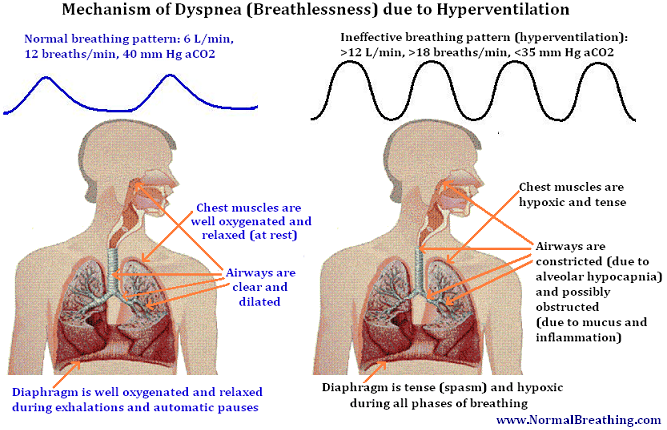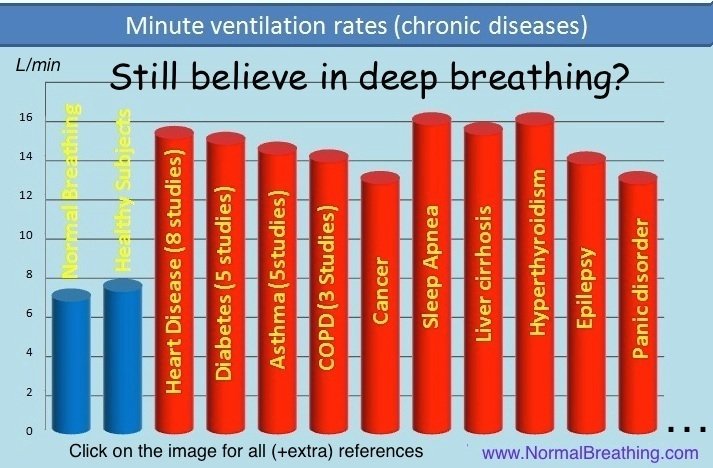- Updated on October 29, 2020
![]() By Dr. Artour Rakhimov, Alternative Health Educator and Author
By Dr. Artour Rakhimov, Alternative Health Educator and Author
- Medically Reviewed by Naziliya Rakhimova, MD
Dyspnea (pronounced as “disp-neah”) is most accurately defined as being unable to take a satisfying deep inspiration (or shortage of air). This weird definition was likely invented by proponents of breathing more air (as if breathing more than the medical norm provides health benefits). Even large official websites promote this implication related to goodness of breathing more air at rest.
The deep cause of dyspnea is in changes in air composition during last 2 millions of years. When first prototypes of lungs were evolving, the air had about 7-12% CO2 and less than 1% O2. This was before advancing of green life. As a result, overbreathing was beneficial for increased tissue oxygenation. Now the situation is reversed, but humans still possess this ancient pathological reflex called “dyspnea”. In modern conditions, overbreathing reduces body oxygenation, and this intensifies the desire to breathe creating a vicious circle.
 Dyspnea is caused by overbreathing (deep breathing), mouth breathing and chest breathing. All these activities reduce brain and body oxygenation and create the sensation of air hunger. Let us start with evidence related to chronic deep breathing in people with dyspnea.
Dyspnea is caused by overbreathing (deep breathing), mouth breathing and chest breathing. All these activities reduce brain and body oxygenation and create the sensation of air hunger. Let us start with evidence related to chronic deep breathing in people with dyspnea.
Chronic hyperventilation (or overbreathing) leads to alveolar hypocapnia (CO2 deficiency) which is normal in people with heart disease, asthma, COPD, cancer, cystic fibrosis, diabetes, pregnancy and many other conditions. Low brain oxygenation (see the brain image above) is the known effect of overbreathing.
Healthy, normal breathing is imperceptible or unperceivable since it is very small (500 ml for tidal volume, 10-12 breaths/min, and 6 L/min for minute ventilation at rest for a 70-kg person). In contrast, dyspneic patients have over 12 L/min (double the norm) for their ventilation rates and over 18 breaths/min for the respiratory frequency at rest. These simple ideas are unknown to most doctors.
Accurately defined cause of dyspnea
Hyperventilation (the major single cause of dyspnea) leads to greatly increased work of breathing due to large minute ventilation rates. But there are other effects as well. For example, alveolar hyperventilation always leads to cell hypoxia (regardless of the ventilation-perfusion ratio).

The main physiological factors (causes of dyspnea) that increase the work of breathing (often several-fold) are:
– constriction of airways due to alveolar hypocapnia
– reduced oxygen tension in the diaphragm and chest muscles due to worsened oxygen transport
– tense states of the diaphragm and chest muscles due to arterial hypocapnia.
 Exacerbating causes in the pathophysiology of dyspnea are:
Exacerbating causes in the pathophysiology of dyspnea are:
– mouth breathing (due to the reduction in nitric oxide absorption and alveolar CO2)
– chest breathing (due to the reduction in the arterial oxygenation)
– presence of inflammation and mucus in airways causing further narrowing or obstruction of air flow.
Exertion, exercise (with mouth breathing), meals (or eating, and especially overeating), overheating, stress, anxiety, attempts to breathe deeply, deep breathing exercises, night sleep and being in the horizontal position (especially supine sleep), poor posture, pregnancy and many other factors are all known causes of hyperventilation. Therefore, these lifestyle factors exacerbate the problem with breathlessness.
For example, physical exertion, due to anaerobic cell respiration at rest and elevated-resting-blood lactate, worsens gas exchange and causes overbreathing. This leads to acute exertional dyspnea.
Acute dyspnea leads to even heavier breathing due to a negative feedback in breathing control caused by a prominent oxygen drive (hunger for air), instead of normal CO2-based regulation of respiration. Respiratory receptors located in the brain sense low-brain oxygenation creating the sensation of air hunger and trying to increase ventilation.
Treatment of dyspnea on exertion
Dyspnea disappears when a person gets more than X s (see details below) for the body-oxygen test in the morning while heart rate of the person should be less than Y beats per minute. This number X is still much less than the medical norm (40 seconds) but is sufficient to solve problems with shortness of breath at rest.
This number X in seconds that guarantees relief from dyspneic symptoms) is provided below here as your bonus content.
20+ seconds 24/7 and for morning CP with less than 80 for pulse ar rest sitting.
[/sociallocker]


